Statistics Assignment
VerifiedAdded on 2023/04/24
|7
|1063
|440
AI Summary
This assignment covers hypothesis testing, type I and type II errors, and probability calculations related to statistics.
Contribute Materials
Your contribution can guide someone’s learning journey. Share your
documents today.
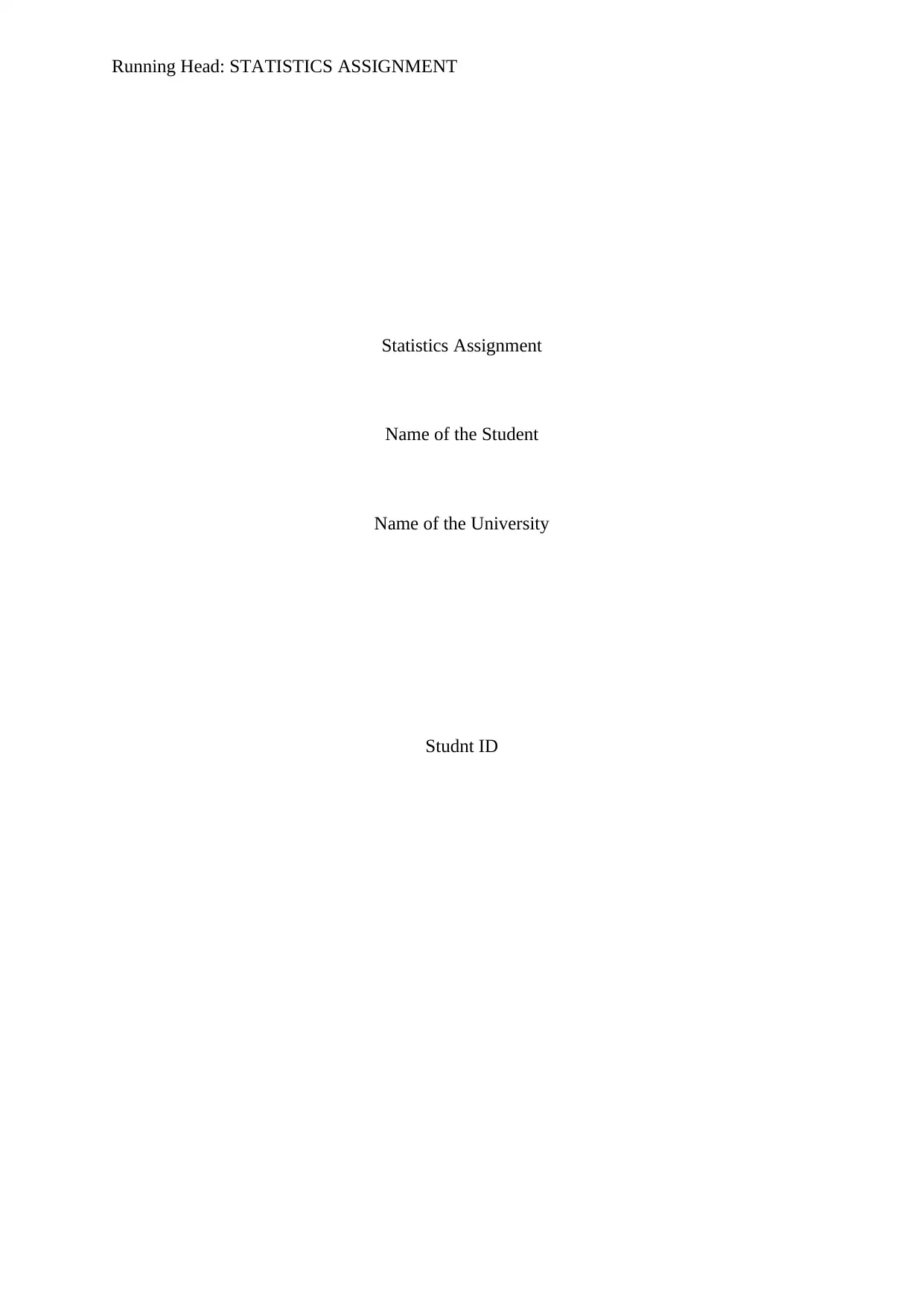
Running Head: STATISTICS ASSIGNMENT
Statistics Assignment
Name of the Student
Name of the University
Studnt ID
Statistics Assignment
Name of the Student
Name of the University
Studnt ID
Secure Best Marks with AI Grader
Need help grading? Try our AI Grader for instant feedback on your assignments.
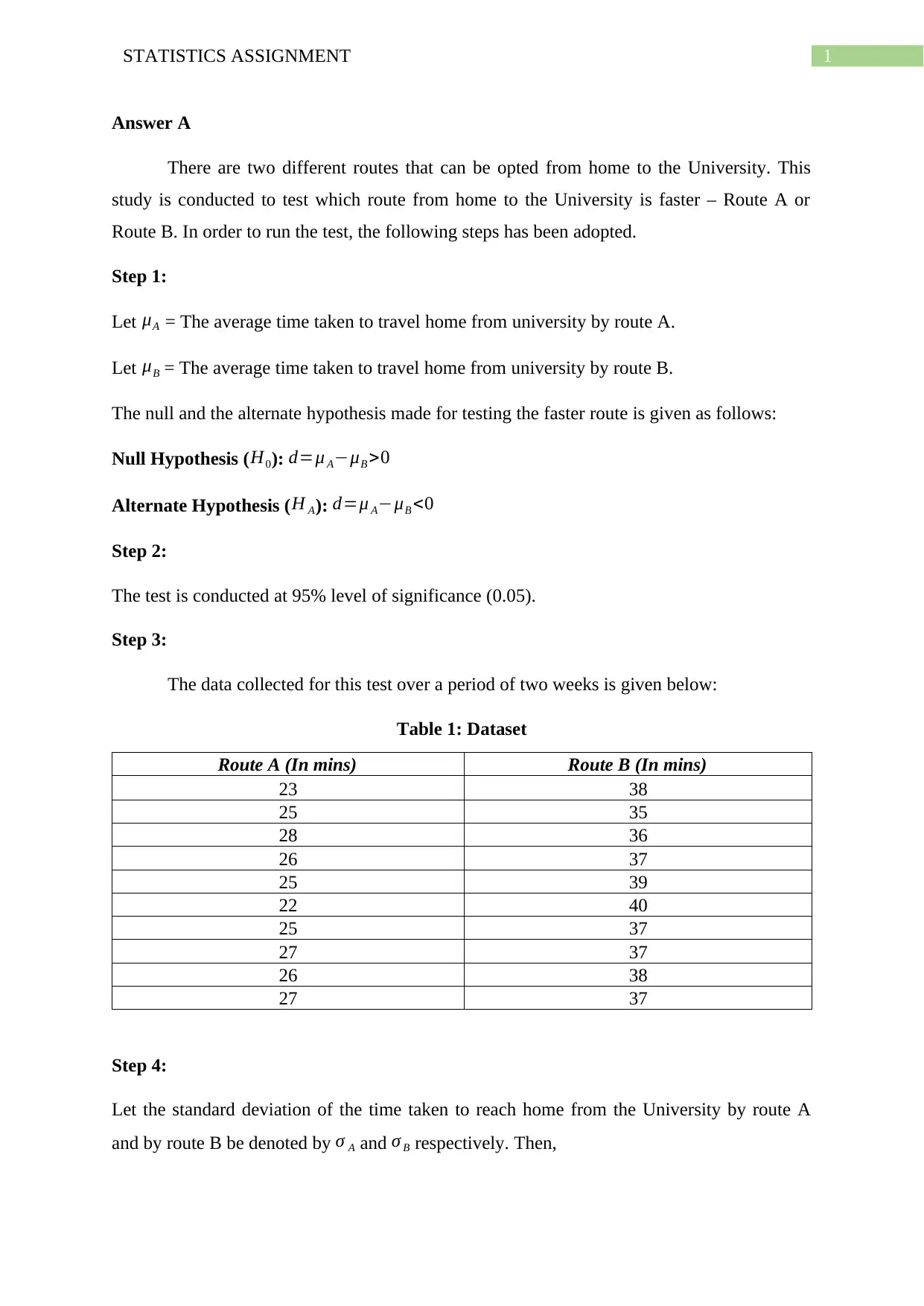
1STATISTICS ASSIGNMENT
Answer A
There are two different routes that can be opted from home to the University. This
study is conducted to test which route from home to the University is faster – Route A or
Route B. In order to run the test, the following steps has been adopted.
Step 1:
Let μA = The average time taken to travel home from university by route A.
Let μB = The average time taken to travel home from university by route B.
The null and the alternate hypothesis made for testing the faster route is given as follows:
Null Hypothesis (H0): d=μ A−μB >0
Alternate Hypothesis ( H A): d=μ A−μB <0
Step 2:
The test is conducted at 95% level of significance (0.05).
Step 3:
The data collected for this test over a period of two weeks is given below:
Table 1: Dataset
Route A (In mins) Route B (In mins)
23 38
25 35
28 36
26 37
25 39
22 40
25 37
27 37
26 38
27 37
Step 4:
Let the standard deviation of the time taken to reach home from the University by route A
and by route B be denoted by σ A and σ B respectively. Then,
Answer A
There are two different routes that can be opted from home to the University. This
study is conducted to test which route from home to the University is faster – Route A or
Route B. In order to run the test, the following steps has been adopted.
Step 1:
Let μA = The average time taken to travel home from university by route A.
Let μB = The average time taken to travel home from university by route B.
The null and the alternate hypothesis made for testing the faster route is given as follows:
Null Hypothesis (H0): d=μ A−μB >0
Alternate Hypothesis ( H A): d=μ A−μB <0
Step 2:
The test is conducted at 95% level of significance (0.05).
Step 3:
The data collected for this test over a period of two weeks is given below:
Table 1: Dataset
Route A (In mins) Route B (In mins)
23 38
25 35
28 36
26 37
25 39
22 40
25 37
27 37
26 38
27 37
Step 4:
Let the standard deviation of the time taken to reach home from the University by route A
and by route B be denoted by σ A and σ B respectively. Then,
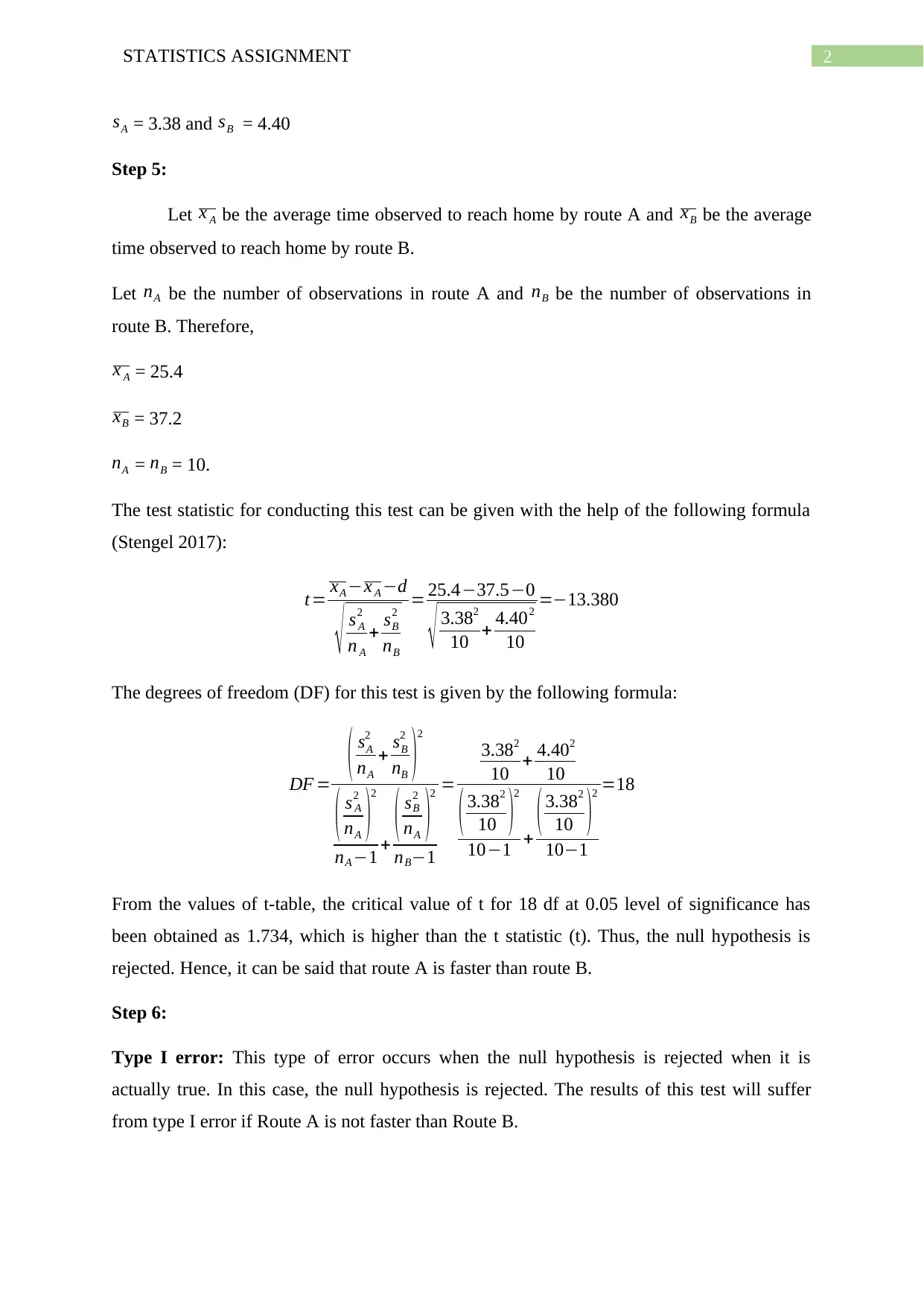
2STATISTICS ASSIGNMENT
sA = 3.38 and sB = 4.40
Step 5:
Let x A be the average time observed to reach home by route A and xB be the average
time observed to reach home by route B.
Let nA be the number of observations in route A and nB be the number of observations in
route B. Therefore,
x A = 25.4
xB = 37.2
nA = nB = 10.
The test statistic for conducting this test can be given with the help of the following formula
(Stengel 2017):
t= xA −x A −d
√ s A
2
n A
+ sB
2
nB
= 25.4−37.5−0
√ 3.382
10 + 4.402
10
=−13.380
The degrees of freedom (DF) for this test is given by the following formula:
DF =
( sA
2
nA
+ sB
2
nB )
2
( s A
2
nA )
2
nA −1 +
( sB
2
nA )
2
nB−1
=
3.382
10 + 4.402
10
( 3.382
10 )
2
10−1 +
( 3.382
10 )
2
10−1
=18
From the values of t-table, the critical value of t for 18 df at 0.05 level of significance has
been obtained as 1.734, which is higher than the t statistic (t). Thus, the null hypothesis is
rejected. Hence, it can be said that route A is faster than route B.
Step 6:
Type I error: This type of error occurs when the null hypothesis is rejected when it is
actually true. In this case, the null hypothesis is rejected. The results of this test will suffer
from type I error if Route A is not faster than Route B.
sA = 3.38 and sB = 4.40
Step 5:
Let x A be the average time observed to reach home by route A and xB be the average
time observed to reach home by route B.
Let nA be the number of observations in route A and nB be the number of observations in
route B. Therefore,
x A = 25.4
xB = 37.2
nA = nB = 10.
The test statistic for conducting this test can be given with the help of the following formula
(Stengel 2017):
t= xA −x A −d
√ s A
2
n A
+ sB
2
nB
= 25.4−37.5−0
√ 3.382
10 + 4.402
10
=−13.380
The degrees of freedom (DF) for this test is given by the following formula:
DF =
( sA
2
nA
+ sB
2
nB )
2
( s A
2
nA )
2
nA −1 +
( sB
2
nA )
2
nB−1
=
3.382
10 + 4.402
10
( 3.382
10 )
2
10−1 +
( 3.382
10 )
2
10−1
=18
From the values of t-table, the critical value of t for 18 df at 0.05 level of significance has
been obtained as 1.734, which is higher than the t statistic (t). Thus, the null hypothesis is
rejected. Hence, it can be said that route A is faster than route B.
Step 6:
Type I error: This type of error occurs when the null hypothesis is rejected when it is
actually true. In this case, the null hypothesis is rejected. The results of this test will suffer
from type I error if Route A is not faster than Route B.
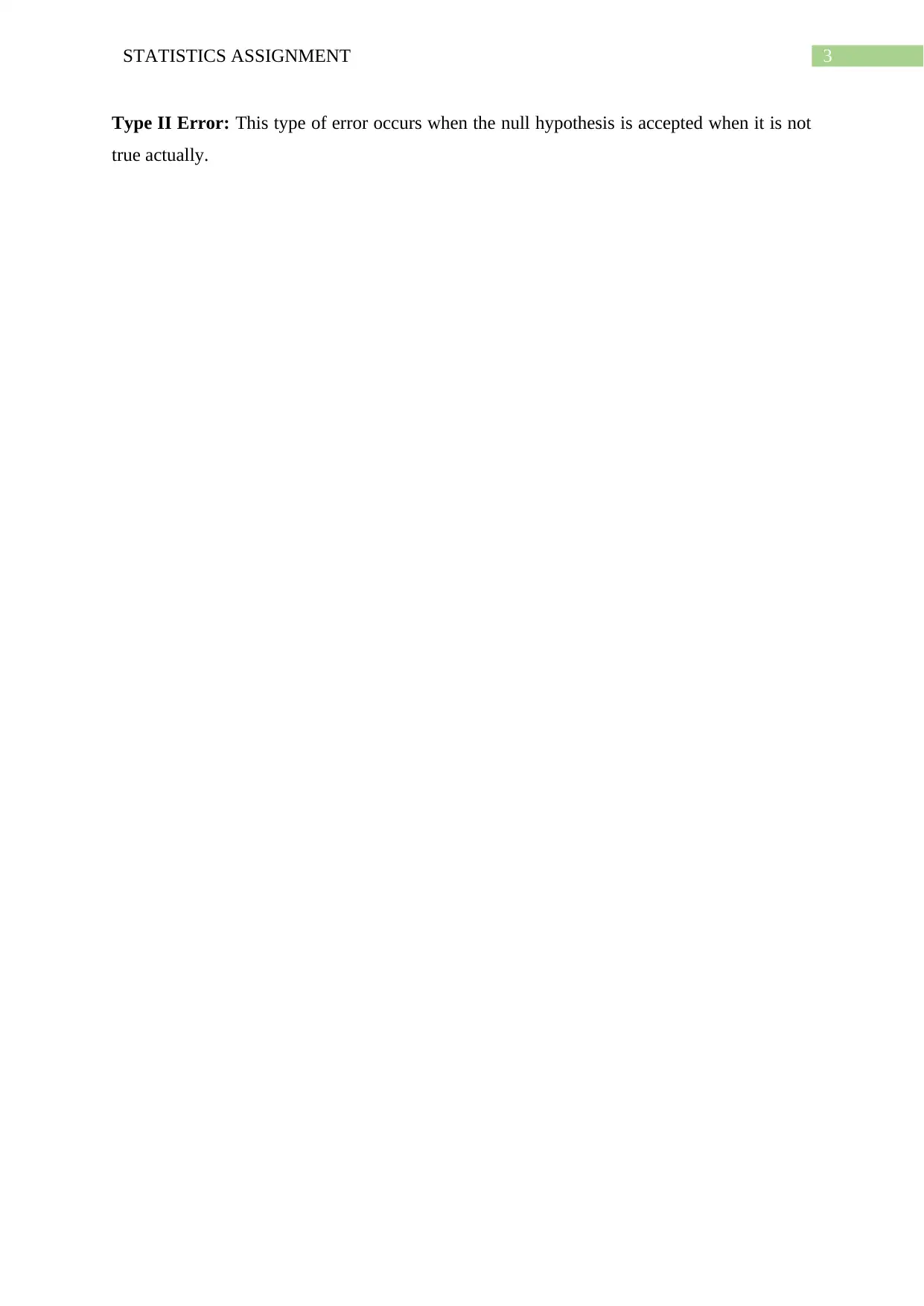
3STATISTICS ASSIGNMENT
Type II Error: This type of error occurs when the null hypothesis is accepted when it is not
true actually.
Type II Error: This type of error occurs when the null hypothesis is accepted when it is not
true actually.
Secure Best Marks with AI Grader
Need help grading? Try our AI Grader for instant feedback on your assignments.
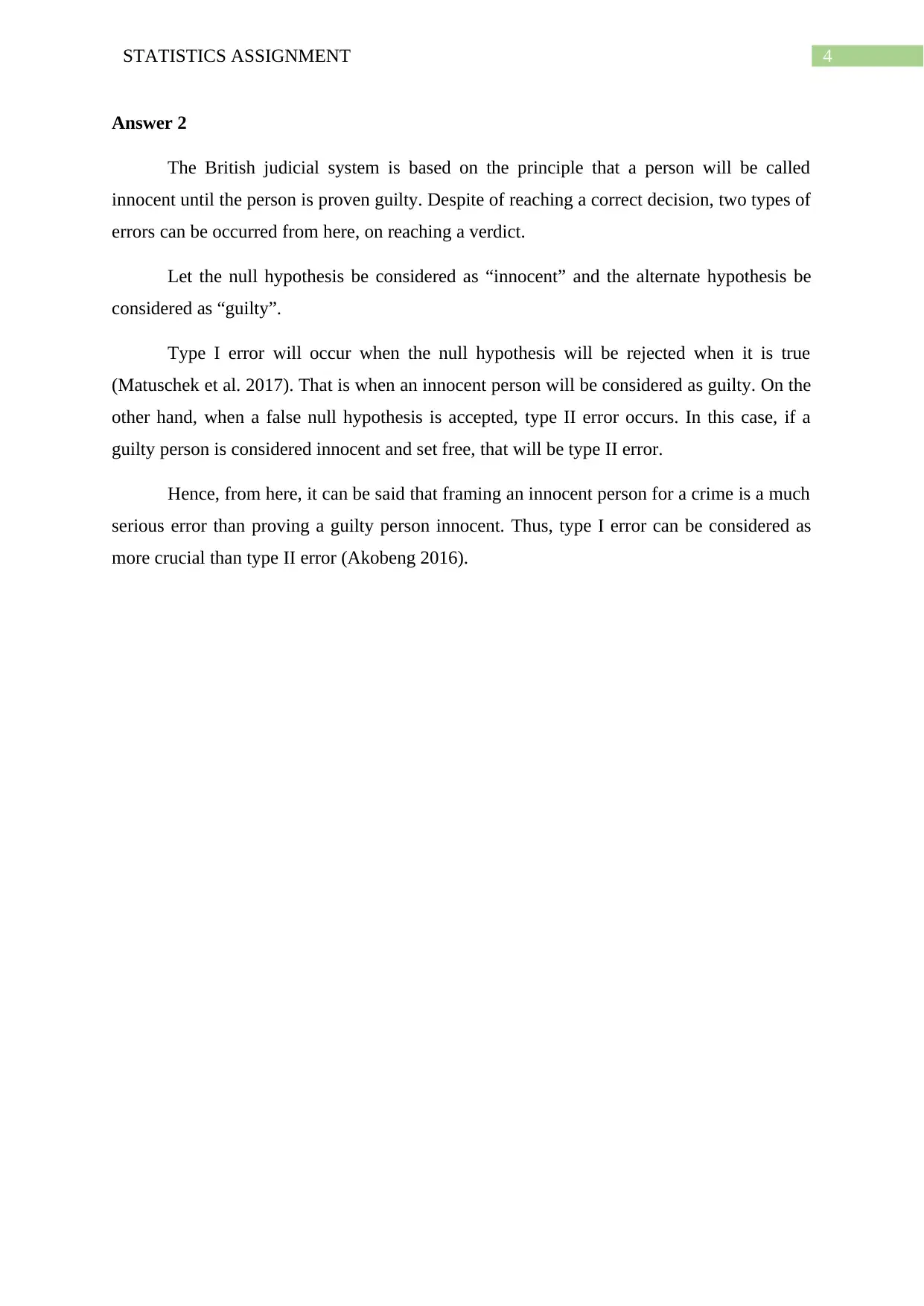
4STATISTICS ASSIGNMENT
Answer 2
The British judicial system is based on the principle that a person will be called
innocent until the person is proven guilty. Despite of reaching a correct decision, two types of
errors can be occurred from here, on reaching a verdict.
Let the null hypothesis be considered as “innocent” and the alternate hypothesis be
considered as “guilty”.
Type I error will occur when the null hypothesis will be rejected when it is true
(Matuschek et al. 2017). That is when an innocent person will be considered as guilty. On the
other hand, when a false null hypothesis is accepted, type II error occurs. In this case, if a
guilty person is considered innocent and set free, that will be type II error.
Hence, from here, it can be said that framing an innocent person for a crime is a much
serious error than proving a guilty person innocent. Thus, type I error can be considered as
more crucial than type II error (Akobeng 2016).
Answer 2
The British judicial system is based on the principle that a person will be called
innocent until the person is proven guilty. Despite of reaching a correct decision, two types of
errors can be occurred from here, on reaching a verdict.
Let the null hypothesis be considered as “innocent” and the alternate hypothesis be
considered as “guilty”.
Type I error will occur when the null hypothesis will be rejected when it is true
(Matuschek et al. 2017). That is when an innocent person will be considered as guilty. On the
other hand, when a false null hypothesis is accepted, type II error occurs. In this case, if a
guilty person is considered innocent and set free, that will be type II error.
Hence, from here, it can be said that framing an innocent person for a crime is a much
serious error than proving a guilty person innocent. Thus, type I error can be considered as
more crucial than type II error (Akobeng 2016).
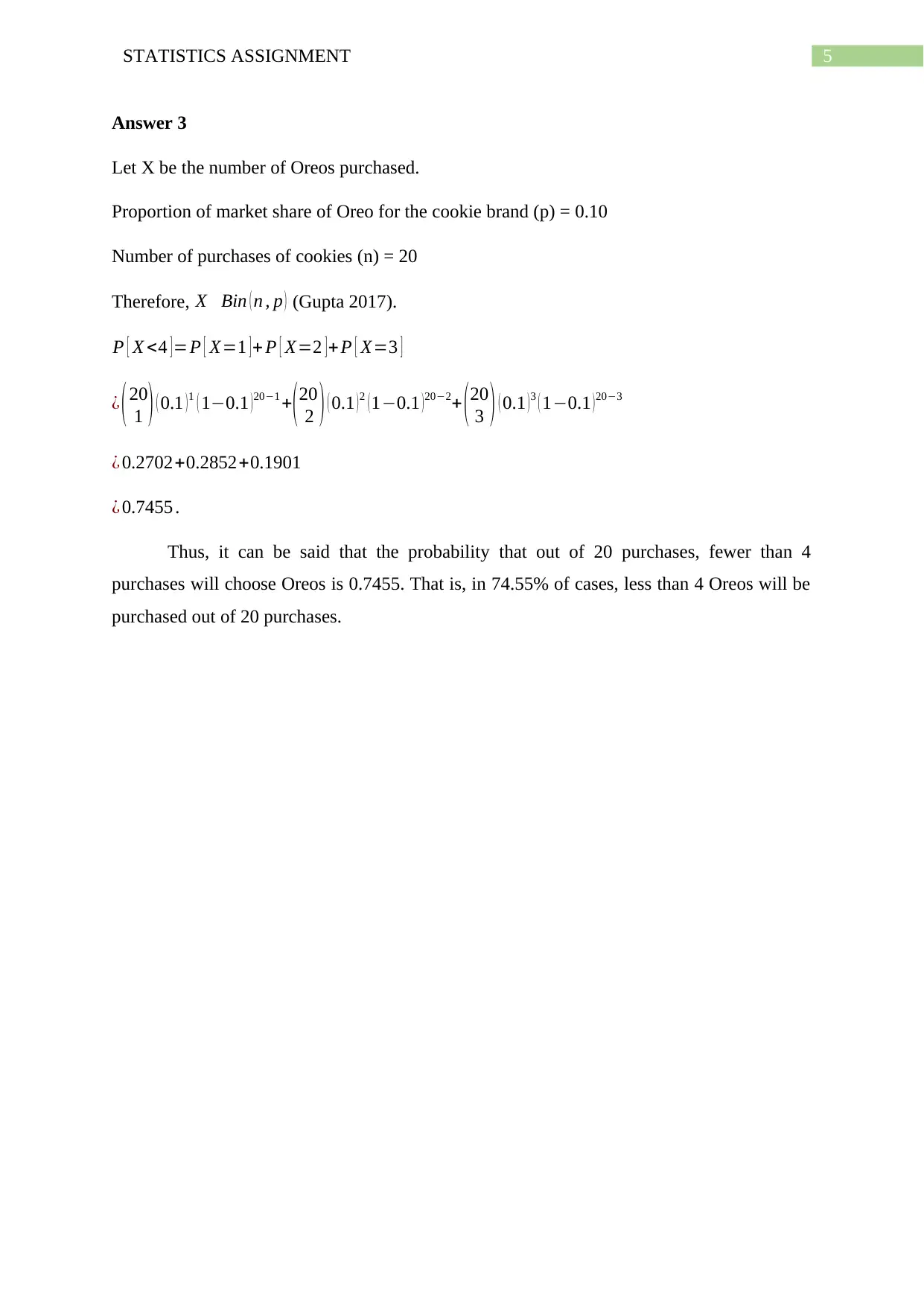
5STATISTICS ASSIGNMENT
Answer 3
Let X be the number of Oreos purchased.
Proportion of market share of Oreo for the cookie brand (p) = 0.10
Number of purchases of cookies (n) = 20
Therefore, X Bin ( n , p ) (Gupta 2017).
P [ X <4 ] =P [ X=1 ] + P [ X=2 ] + P [ X=3 ]
¿ ( 20
1 ) ( 0.1 ) 1 ( 1−0.1 ) 20−1 +( 20
2 ) ( 0.1 ) 2 ( 1−0.1 ) 20−2+ ( 20
3 ) ( 0.1 ) 3 ( 1−0.1 ) 20−3
¿ 0.2702+0.2852+0.1901
¿ 0.7455 .
Thus, it can be said that the probability that out of 20 purchases, fewer than 4
purchases will choose Oreos is 0.7455. That is, in 74.55% of cases, less than 4 Oreos will be
purchased out of 20 purchases.
Answer 3
Let X be the number of Oreos purchased.
Proportion of market share of Oreo for the cookie brand (p) = 0.10
Number of purchases of cookies (n) = 20
Therefore, X Bin ( n , p ) (Gupta 2017).
P [ X <4 ] =P [ X=1 ] + P [ X=2 ] + P [ X=3 ]
¿ ( 20
1 ) ( 0.1 ) 1 ( 1−0.1 ) 20−1 +( 20
2 ) ( 0.1 ) 2 ( 1−0.1 ) 20−2+ ( 20
3 ) ( 0.1 ) 3 ( 1−0.1 ) 20−3
¿ 0.2702+0.2852+0.1901
¿ 0.7455 .
Thus, it can be said that the probability that out of 20 purchases, fewer than 4
purchases will choose Oreos is 0.7455. That is, in 74.55% of cases, less than 4 Oreos will be
purchased out of 20 purchases.
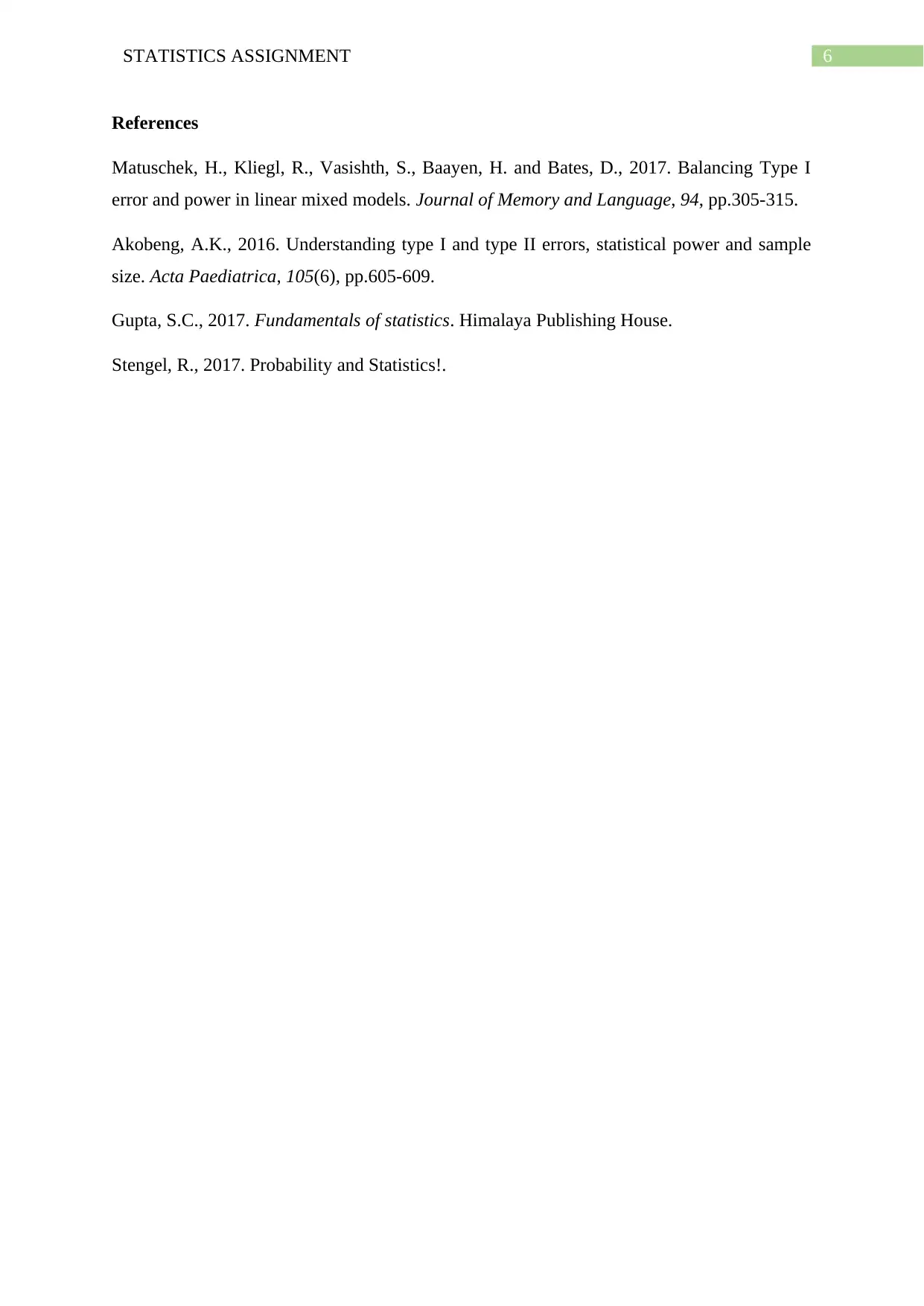
6STATISTICS ASSIGNMENT
References
Matuschek, H., Kliegl, R., Vasishth, S., Baayen, H. and Bates, D., 2017. Balancing Type I
error and power in linear mixed models. Journal of Memory and Language, 94, pp.305-315.
Akobeng, A.K., 2016. Understanding type I and type II errors, statistical power and sample
size. Acta Paediatrica, 105(6), pp.605-609.
Gupta, S.C., 2017. Fundamentals of statistics. Himalaya Publishing House.
Stengel, R., 2017. Probability and Statistics!.
References
Matuschek, H., Kliegl, R., Vasishth, S., Baayen, H. and Bates, D., 2017. Balancing Type I
error and power in linear mixed models. Journal of Memory and Language, 94, pp.305-315.
Akobeng, A.K., 2016. Understanding type I and type II errors, statistical power and sample
size. Acta Paediatrica, 105(6), pp.605-609.
Gupta, S.C., 2017. Fundamentals of statistics. Himalaya Publishing House.
Stengel, R., 2017. Probability and Statistics!.
1 out of 7
Related Documents
Your All-in-One AI-Powered Toolkit for Academic Success.
+13062052269
info@desklib.com
Available 24*7 on WhatsApp / Email
![[object Object]](/_next/static/media/star-bottom.7253800d.svg)
Unlock your academic potential
© 2024 | Zucol Services PVT LTD | All rights reserved.




